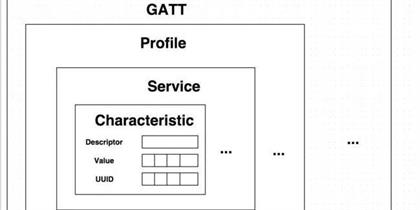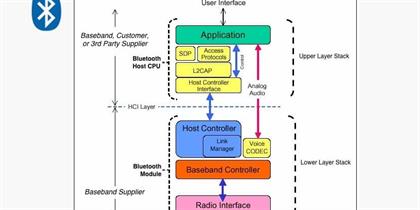
Demystifying the Bluetooth LE Stack
September 10, 2024

Bluetooth LE Stack
The advent of the Internet of Things (IoT) has brought about a surge in the demand for efficient, reliable, and energy-conscious wireless communication protocols. Bluetooth Low Energy (LE) technology has emerged as a frontrunner in this domain, offering a robust framework for connecting a myriad of devices. Central to the operation of Bluetooth LE is its protocol stack, a meticulously designed set of rules and guidelines that govern how devices communicate. This article aims to unravel the complexities of the Bluetooth LE stack, exploring its architecture, functionalities, and the pivotal role it plays in IoT ecosystems.
The Bluetooth LE Stack Architecture
The Bluetooth LE stack is a layered structure, each level contributing to the seamless operation of Bluetooth-enabled devices. The stack is broadly divided into three segments: the Controller, the Host, and the Application layers.
- Controller: This is the backbone of the Bluetooth LE stack, handling the low-level operations such as radio frequency (RF) communication, link management, and the processing of data packets. It encompasses the Physical Layer (PHY), which deals with the transmission and reception of raw bits over the airwaves, and the Link Layer (LL), responsible for managing the Bluetooth LE radio states and ensuring data integrity through error checking and correction mechanisms.
- Host: The host layer sits above the controller and is responsible for higher-level operations such as device discovery, connection management, and data transfer. It includes the Logical Link Control and Adaptation Protocol (L2CAP), which segments and reassembles data to accommodate the link layer’s capabilities, and the Attribute Protocol (ATT), which facilitates the exchange of data between devices by defining a set of attributes and their corresponding operations.
- Application: The application layer is the topmost tier of the stack, where user applications interact with the Bluetooth LE protocol. It comprises various profiles and services that define specific use cases and application scenarios, such as health and fitness tracking, home automation, and asset tracking.
The Role of Profiles and Services
Profiles and services are integral to the Bluetooth LE stack, providing standardized interfaces for different applications. They ensure interoperability between devices from various manufacturers by defining the structure of data and the operations that can be performed on it.
- Generic Access Profile (GAP): GAP defines the roles that devices can assume during communication, such as broadcaster, observer, peripheral, and central. It also manages non-connection-based communication like advertising and scanning.
- Generic Attribute Profile (GATT): GATT is responsible for the organization and management of attributes, which are the basic units of data exchange in Bluetooth LE. It groups attributes into services and allows for the discovery and access control of these services.
- Security Manager Protocol (SMP): SMP oversees the security aspects of Bluetooth LE communication, including encryption, pairing, and authentication, ensuring that data transmission is secure and tamper-proof.
The Evolution of Bluetooth LE Stack
With each iteration of the Bluetooth specification, the LE stack has evolved to accommodate new features and improvements. Bluetooth 5 introduced features like longer range, faster data rates, and increased broadcast message capacity. Bluetooth 5.1 brought about improved accuracy through angle of arrival and departure, while Bluetooth 5.2 enhanced connection-oriented channels and advertising.
The Future of Bluetooth LE Stack
As IoT continues to expand, the Bluetooth LE stack is expected to evolve further, incorporating features like mesh networking, enhanced security, and better power management. The ongoing development of the stack aims to support the growing demands of IoT devices, ensuring that Bluetooth LE remains a versatile and efficient communication protocol.
Conclusion
The Bluetooth Low Energy stack is a sophisticated structure that enables the efficient and reliable operation of IoT devices. Its layered architecture allows for a clear separation of responsibilities, from the low-level radio communication handled by the controller to the high-level application interactions managed by the application layer. As the IoT landscape continues to evolve, the Bluetooth LE stack will undoubtedly adapt, ensuring that Bluetooth technology remains at the forefront of wireless communication.
Leave a Reply
Related Products
You Might Like Also

In the intricate world of Bluetooth Low Energy (BLE) communications, the Generic Attribute Profile (GATT) plays a pivotal role in defining the structure and methods for data exchange. Central to this are the processes of Notifications and Indications, which are the primary means by which GATT servers update clients about changes in attribute values Read More

Central to BLE’s functionality is the BLE Generic Attribute Profile (BLE GATT), which serves as the protocol’s backbone, enabling efficient and structured data communication between devices. This article aims to provide an in-depth exploration of GATT, its components, and its role in BLE technology. Read More

In the realm of wireless communication, Bluetooth advertising has carved out a niche for itself, becoming an indispensable technology for short-range connectivity. At the heart of Bluetooth functionality lies the advertising process, which is the cornerstone for device discoverability and connection establishment. This article delves into the intri Read More

Bluetooth data structures are the foundational elements that govern how data is packaged, transmitted, and received within the Bluetooth ecosystem. These structures are designed to optimize the efficiency and reliability of wireless communication, ensuring that data is handled effectively across various devices and platforms. Read More

In the intricate world of wireless communication, Bluetooth Protocol Stack has established itself as a cornerstone technology, facilitating seamless connectivity between a plethora of devices. At the heart of this technology lies the Bluetooth protocol stack, a structured set of protocols that govern how devices communicate. One of the most critica Read More

In the intricate world of wireless communication, the Bluetooth Generic Access Profile (Bluetooth GAP) of Bluetooth technology stands as a cornerstone, enabling devices to connect, communicate, and collaborate seamlessly. This article delves into the essence of Bluetooth GAP, its role in establishing connections, and the myriad ways it enhances our Read More











